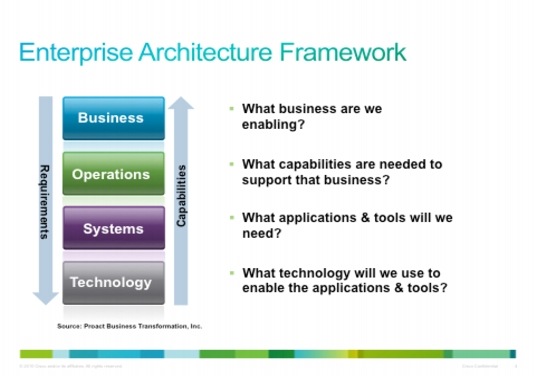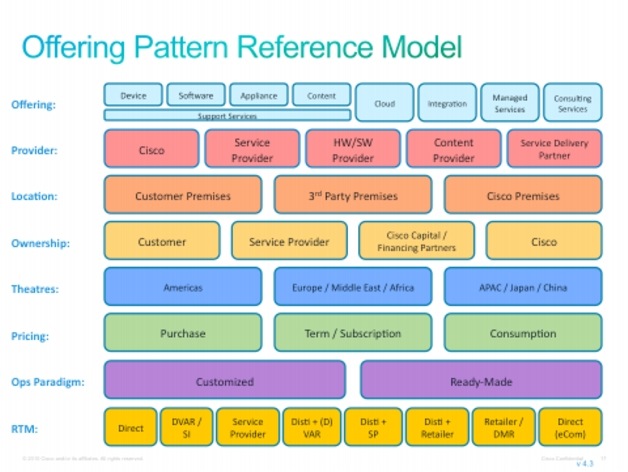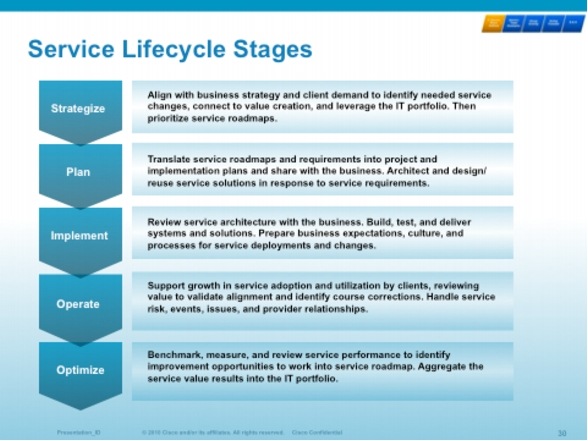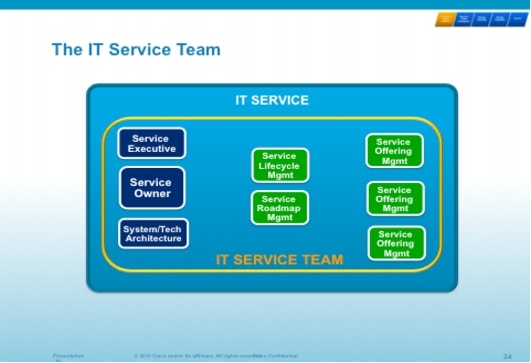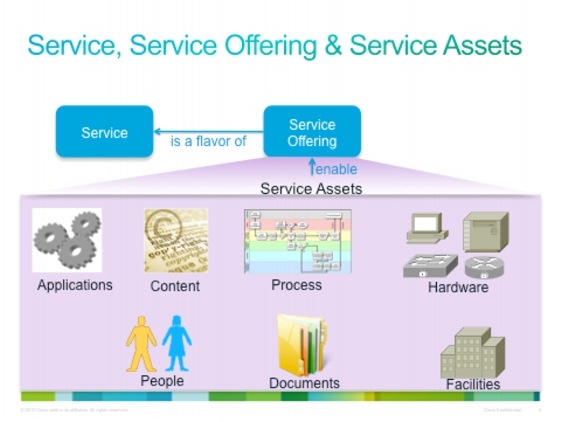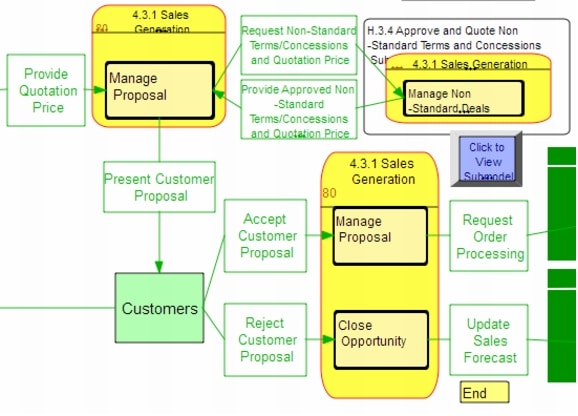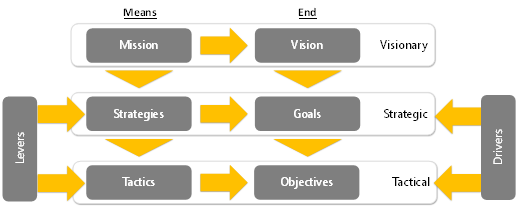Enterprise Architecture in Spain. ------------------------------------------------------------------------------------------------------- Arquitectura Empresarial en España. ---------------------------------------------------------------------------------------------------- A collection of EA things (post, twits, files, blogs...) I find on the internet (TOGAF, Zachman, PEAF, FEAF, Gartner ...)
lunes, 30 de septiembre de 2013
EA and Capabilities
Come Join Me And Influence Enterprise Architecture Capabilities And Business Architecture
- See more at: http://www.mikethearchitect.com/2013/09/come-join-me-and-influence-enterprise-architecture-capabilities-and-business-architecture.html#sthash.tTeDOGmz.dpufEnterprise architecture means better business, pure and simple
http://www.zdnet.com/enterprise-architecture-means-better-business-pure-and-simple-7000021007/
If you think it's tough to structure IT around enterprise architecture, imagine how tough it is running a business without it.
 Phpto credit: Michael Krigsman
Phpto credit: Michael Krigsman
That's the gist of Tom Graves' latest post, as he makes a compelling business case for enterprise architecture, reminding us that EA goes far beyond the walls of the data center.
Tom reminds everyone that enterprise architecture isn't just the technology; the need for it starts when the customer walks in the door (or calls in, or visits the web page, whaatever the case may be). Processes start to kick off, requiring an "architecture of responsibility."
For example, a customer walking into a bank to straighten out a credit-card issue may encounter a series of silos before the issue is resolved. "When an organization’s systems are fragmented by arbitrary boundaries, users have to resort to error-prone kludges such as handwritten notes in order to bridge the gaps," Tom says.
Fragmented processes slow down many customer-facing situations. This is fertile ground for enterprise architects -- a set of customer processes that should last five minutes takes up to an hour.
"It’s the job of an enterprise architect to find a better way to do it, and work with others in the organization – solution architects, system designers, service designers, project managers and more – to get that better way designed and built and put into practice. Doing so would require a far broader scope than just IT. It needs an holistic view of the activities as a whole; it needs to understand not just the IT-based processes, but the human processes, and human responsibilities too; it needs to identify and clean up the kludges that people have to do to get round the limitations of the system."
This is hard work, and will surely be bogged down at points by organizational politics. But it beats the alternative -- a bogged-down organization.
Enterprise architecture means better business, pure and simple
http://www.zdnet.com/enterprise-architecture-means-better-business-pure-and-simple-7000021007/
That's the gist of Tom Graves' latest post, as he makes a compelling business case for enterprise architecture, reminding us that EA goes far beyond the walls of the data center.
Tom reminds everyone that enterprise architecture isn't just the technology; the need for it starts when the customer walks in the door (or calls in, or visits the web page, whaatever the case may be). Processes start to kick off, requiring an "architecture of responsibility."
For example, a customer walking into a bank to straighten out a credit-card issue may encounter a series of silos before the issue is resolved. "When an organization’s systems are fragmented by arbitrary boundaries, users have to resort to error-prone kludges such as handwritten notes in order to bridge the gaps," Tom says.
Fragmented processes slow down many customer-facing situations. This is fertile ground for enterprise architects -- a set of customer processes that should last five minutes takes up to an hour.
"It’s the job of an enterprise architect to find a better way to do it, and work with others in the organization – solution architects, system designers, service designers, project managers and more – to get that better way designed and built and put into practice. Doing so would require a far broader scope than just IT. It needs an holistic view of the activities as a whole; it needs to understand not just the IT-based processes, but the human processes, and human responsibilities too; it needs to identify and clean up the kludges that people have to do to get round the limitations of the system."
This is hard work, and will surely be bogged down at points by organizational politics. But it beats the alternative -- a bogged-down organization.
16 IT Skills in High Demand in 2013
http://www.cio.com/slideshow/detail/119877?goback=%2Egde_36248_member_275922308#slide9
8. Enterprise Architecture Skills
Companies are applying the lessons learned from years of business architecture and are now trying to incorporate those lessons into the parts of the job that deal with technology and data. According to Foote, architecture roles are about the long term and are hard to justify ROI. As a result when the economic downturn happened in 2009 and 2010, many companies shed their network and other IT architects.
"A lot of companies took down and disassembled their enterprise architecture groups. That's all changed now. You can't do advanced analytics without a lot of data cleansing, data quality analysis, data management and data architecture, says Foote.
Enterprise Architecture has grown 30.8 percent in value/demand over the last 12 months.
Salary Range: $91,000-$134,000
domingo, 29 de septiembre de 2013
Devoteam - TOGAF Certified Enterprise Architect
http://jobs.ictjob.be/Devoteam-_-TOGAF-Certified-Enterprise-Architect__48068
Job description
- As consultant in Enterprise Architecture you own the process for the development and maintenance of the overall Global Enterprise architecture definition and roadmap at our customers.
- You have the transversal view to lead, recommend and set the decided technical blueprint for the enterprise IT architecture evolution based on the business & organizational requirements, best practices, technology evolution and your professional experiences.
- You validate that proposed solutions (will) function according to the requirements and technical/process/policies/financial feasibility.
- You guide the implementation programs and assist the stakeholders in understanding the change management and end-user adoption.
- You conduct Enterprise IT assessments (Infrastructure, Enterprise Business Applications), analyze IT maturity and do recommendations on IT roadmap, TCO evolution and ROI.
- You work in close collaboration with experts in middleware, enterprise applications, security, and processes.
- You report to the project manager.
- As technical lead responsible you participate in all stages of the RFP process (customer - supplier - 3rd party vendors)
- You work on the customer's premise and in-house at Devoteam.
Profile specification
- You are TOGAF Certified and have strong analytical skills
- You are a strong technical generalist with broad technology knowledge on Enterprise IT: architectures, infrastructure platforms, application servers, databases, virtualization, cloud computing.
- Deep knowledge is some areas are an advantage.
- You are a facilitator with strong communication, documentation. (design/define/document), reporting and presentation skills.
- You have a business attitude with a solution driven 'Can do attitude': able to work creatively and analytically in a problem-solving environment and execute effectively with or without clear instructions.
- You are experienced working in large organizations and in multiple projects.
- You have fluent oral/written communication skills in English, at least fluent oral/written communication skills in Dutch and/or French.
- You have a master degree or equivalent by experience.
We offer
- A challenging and variable job in an international and dynamic company.
- Thanks to the personal follow up we are able to provide real career opportunities and planning.
-
An attractive salary plus interesting fringe benefits like a company car.
EA GArtner definition
“Enterprise Architecture (EA) is a discipline for proactively and holistically leading enterprise responses to disruptive forces by identifying and analyzing the execution of change toward desired business vision and outcomes.”
“EA practitioners have the opportunity to take a quantum leap toward not only becoming integral to the business, but also leading business change.”
Source: Hype Cycle for Enterprise Architecture 2013, Gartner 2013
Hype Cycle for Enterprise Architecture, 2013
- Analysis
- What You Need to Know
- The Hype Cycle
- Business-Outcome-Driven EA: A Quantum Leap to Delivering Value
- Top Opportunities and Challenges EA Practitioners Face Today
- Business-Outcome-Driven EA: A Quantum Leap to Delivering Value
- EA Programs Are Taking Into Account Major Disruptive Trends
- The Future of EA 2020
- Highlights of the 2013 Hype Cycle
- The Priority Matrix
- Off the Hype Cycle
- Enterprise Technology Architecture
- On the Rise
- Internet of Things Impact on EA
- Business Ecosystem Modeling
- EA Consultancies
- Social Media Strategic Impact on EA
- Impact of Risk on EA
- Information Impact on EA
- EA Road Maps
- IT/OT Impact on EA
- Mobile Impact on EA
- At the Peak
- Cloud Computing Impact on EA
- EA Governance
- Business Capability Modeling
- EA Certification
- Enterprise Business Architecture
- Internet of Things
- Big Data
- Social Network Analysis
- Enterprise Information Architecture
- Gamification
- Hybrid Cloud Computing
- Third-Party Risk Management
- Sliding Into the Trough
- Social Analytics
- Enterprise Solution Architecture
- EA Frameworks
- Cloud Computing
- Blended Enterprise Architecture Approach
- Climbing the Slope
- Enterprise Architecture Tools
- Enterprise Architecture
- EA Assurance
- Mobile Device Management
- Appendixes
- Hype Cycle Phases, Benefit Ratings and Maturity Levels
- Recommended Reading
TABLES
lunes, 23 de septiembre de 2013
domingo, 22 de septiembre de 2013
miércoles, 18 de septiembre de 2013
martes, 17 de septiembre de 2013
Strategy Links
Strategy Maps
http://www.balancedscorecards.com/common-questions/what-are-strategy-maps/
Balanced Scorecard – Example
http://www.theclci.com/products_PMMS-BSC-pop-up02.htm
http://tomonleadership.com/resources/balanced-scorecard-and-strategy-map/
http://www.bized.co.uk/educators/16-19/business/strategy/presentation/busstrategy_map.htm

Anatomy of an IT Strategic Plan
http://www.cio.com/article/174253/Anatomy_of_an_IT_Strategic_Plan
EA Tools
General & ICT management consultant
Thank you so far for the valuable feedback:
A scan on the market for tools strong in modelling results in the following list:
Commercial Architecture Modelling tools:
Enterprise Architect from Sparx Systems (http://www.sparxsystems.com/),
Together from Borland (http://www.borland.com/products/together/),
Visual Studio 2012 from Microsoft (http://msdn.microsoft.com/en-us/library/vstudio/dd490886.aspx),
Rational Software Architect from IBM (http://www-03.ibm.com/software/products/us/en/ratisoftarch/),
Enterprise Architect Solution from Modelio (http://www.modeliosoft.com/en/technologies/enterprise-architecture.html),
ABACUS from Avolution (http://www.avolution.com.au/),
Visualize from CASEWISE (http://www.casewise.com/products),
ProVision Enterprise Architecture & IT Planning from OPENTEXT (http://bps.opentext.com/products/product/provision-enterprise-architecture-it-planning),
TrouxView Software from troux (http://www.troux.com/products/troux_software/),
Enterprise Architecture from mega (http://www.mega.com/en/solution/business-architecture),
ARIS Business Architect & Designer from Software AG (http://www.softwareag.com/us/products/aris_platform/aris_design/business_architect/capabilities/default.asp),
Open source Architecture Modelling tools:
Archi (http://archi.cetis.ac.uk/),
BEASI for our TOGAF and ArchiMate http://www.biner.se/en/methods/binereasi
StarUML! Best GPL UML modeling tool out there
yEd Graph Editor, i
Sparx EA (IT application perspective) and EasyVista, a CMDN tool to cover the infrastructure perspective
We use Iteraplan, http://www.iteraplan.com/en/download
IServer.
BiZZdesign at that current list. Have a look at http://www.bizzdesign.com/consultancy/enterprise-architecture-management/
lunes, 16 de septiembre de 2013
domingo, 15 de septiembre de 2013
Business Architecture Summit – March 2014
Business Architecture Innovation Summit March 2014: Call for Abstracts
Sponsored by the Business Architecture Guild & OMG Business Architecture SIG
Location: Hyatt Regency Reston, Reston VA, USA (Washington DC)
Date: March 25-26, 2014
Abstract Submission Due Date: Oct. 11, 2013
Call for Abstracts: The Business Architecture Guild is calling for presentation abstract submissions for the Business Architecture Summit being held in Reston, VA on March 25-26, 2014. An overview of the two-day event is below. Day one will feature a number of topical sessions by experts and practitioners. Day two will focus on practitioner experiences and case studies from various industry sectors.
The Summit is seeking business architecture abstracts from corporations and government agencies. This includes executive sessions as well as practitioners. Vendor submissions from organizations offering consulting services and / or software tools will be given low priority over submissions from business professionals at corporations and government agencies.
Presentations times and formats will vary and be augmented with panel sessions where speakers can further engage with attendees. Suggested abstract topics are provided below.
Suggested Abstract Submission Topics:
-
The Value of Business Architecture: An Executive Perspective
-
The Value Proposition of Business Architecture: A Stakeholder Perspective
-
Tying Business Architecture to Business Strategy
-
Strategy Mapping, Performance Analysis & Business Architecture
-
Designing and Managing the Business Architecture Practice
-
Governance and Business Architecture Competencies
-
Aligning Business Models with Business Architecture
-
Defining a Standard Framework for Business Architecture
-
Aligning Business Architecture & Enterprise Architecture
-
Developing and Applying Capability Maps, Value Maps and Other Business Blueprint
-
Business Architecture & Solution Deployment Strategies
-
Business-Driven Roadmaps, Funding & Initiatives
-
Establishing a Business Architecture Maturity Model
-
Business Architecture Practitioner Experiences
-
Business Architecture Case Studies for Startups
Abstract Submission Instructions:
Submission Format:
Abstracts should contain:
-
Session Topic Title
-
One-paragraph, 4-5 sentence abstract description
-
Submitter’s Name, Company, Title, Email, Phone #
-
One hundred word bio of relevant background
Submit Abstract responses to: Info@BusinessArchitectureGuild.org
For Questions - email: admin@businessarchitectureguild.org
Business Architecture Summit – March 2014
Sponsored by the Business Architecture Guild & OMG Business Architecture SIG
Overview
Business architecture is enabling a variety of business strategies, business solutions and priority initiatives at organizations worldwide. The two-day Business Architecture Innovation Summit takes attendees on a journey through leading edge concepts and best practices, coupled with executive and practitioner case studies. Be ready to go beyond simplistic notions and immerse yourself in business architecture – from state-of-the-art through state-of-the-practice.
Day 1: Business Architecture: An End-to-End Experience
Industry best practices, a formal body of knowledge, standards and supporting automation continue to coalesce into a mature business architecture ecosystem. Day one of the Business Architecture Innovation Summit features leading experts in business innovation, strategy and transformation, business design, business blueprint mapping, funding and initiative analysis, solution delivery, and business / IT alignment. Leading experts and practitioners take attendees from strategic planning and innovation, through business analysis and transformation – offering an end-to-end view of business architecture and how it can benefit your organization.
Day 2: Business Architecture: Customer Success Stories
Day two of the Business Architecture Innovation Summit features customer cases studies, bringing attendees pragmatic deployment stories from organizations that are benefitting from business architecture. Attendees will hear practitioners share success stories from a variety of industries such as financial services, insurance, manufacturing, government and transportation. Attendees will hear how other organizations built executive support, implemented solutions, achieved value, addressed pitfalls and deployed innovative solutions.
Dates & Location
The Business Architecture Innovation Summit will be held in Reston, VA on March 25-26, 2014. Mark your calendars and prepare for the ultimate summit on business architecture. The summit is being sponsored by the Business Architecture Guild and the OMG Business Architecture Special Interest Group.
jueves, 12 de septiembre de 2013
Business Strategy
http://iveybusinessjournal.com/topics/strategy/what-is-corporate-strategy-really#.UjCxWBt7I1I
http://www.tutor2u.net/business/strategy/what_is_strategy.htm
http://www.briefcasebooks.com/formisano01.pdf
http://www.wisegeek.org/what-is-a-business-strategy.htm
http://businesscasestudies.co.uk/business-theory/strategy/business-strategy.html#axzz2ebnxqTl6
miércoles, 11 de septiembre de 2013
martes, 10 de septiembre de 2013
lunes, 9 de septiembre de 2013
Ten Ways to Kill An Enterprise Architecture Practice
Have you seen practices that you know could kill an Enterprise Architecture practice? I have. A recent LinkedIn thread asked for examples, and I came up with my top ten. I’d love to hear your additions to the list.
How to screw up an EA practice
- Get a senior leader to ask for EA without any idea of what he is going to get for it. If necessary, lie. Tell leaders that EA will improve their agility or reduce complexity without telling them that THEY and THEIR BUSINESS will have to change.
- Set no goals. Allow individual architects to find their own architecture opportunities and to do them any way they want. Encourage cowboy architecture.
- Buy a tool first. Tell everyone that they need to wait for results until the tool is implemented and all the integration is complete.
- Get everyone trained on a "shell framework" like Zachman. Then tell your stakeholders that using the framework will provide immediate benefits.
- Work with stakeholders to make sure that your EA's are involved in their processes without any clear idea of what the EA is supposed to do there. Just toss 'em in and let them float.
- Delete all the data from your tool. Give no one any reason why. You were just having a bad hair day.
- Get in front of the most senior people you can, and when you get there, tell them how badly they do strategic planning.
- Change your offerings every four months. Each time, only share the new set of architectural services with about 20% of your stakeholders.
- Create a conceptual model of the enterprise that uses terms that no one in the enterprise uses. Refer to well known business thinkers as sources. When people complain, tell them that they are wrong. Never allow aliases.
- Every time you touch an IT project, slow it down. Occasionally throw a fit and stop an IT project just for fun. Escalate as high as you can every time. Win your battles at all costs.
